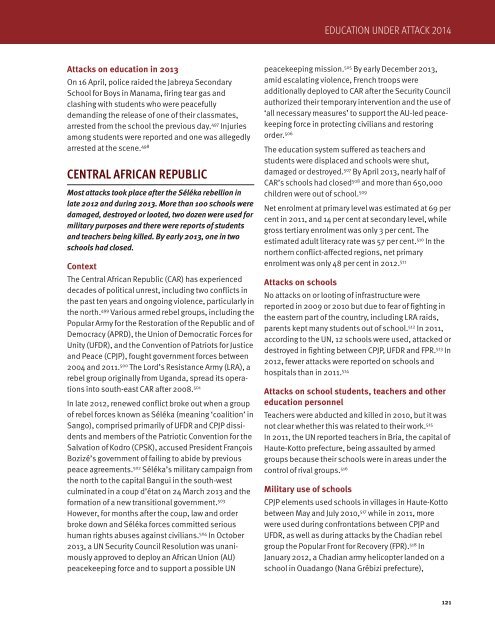eua_2014_full.pdf?utm_content=buffer4a392&utm_medium=social&utm_source=twitter
eua_2014_full.pdf?utm_content=buffer4a392&utm_medium=social&utm_source=twitter
eua_2014_full.pdf?utm_content=buffer4a392&utm_medium=social&utm_source=twitter
- No tags were found...
Create successful ePaper yourself
Turn your PDF publications into a flip-book with our unique Google optimized e-Paper software.
EDUCATION UNDER ATTACK <strong>2014</strong>Attacks on education in 2013On 16 April, police raided the Jabreya SecondarySchool for Boys in Manama, firing tear gas andclashing with students who were peace<strong>full</strong>ydemanding the release of one of their classmates,arrested from the school the previous day. 497 Injuriesamong students were reported and one was allegedlyarrested at the scene. 498CeNTRAL AFRICAN RePUBLICMost attacks took place after the Séléka rebellion inlate 2012 and during 2013. More than 100 schools weredamaged, destroyed or looted, two dozen were used formilitary purposes and there were reports of studentsand teachers being killed. By early 2013, one in twoschools had closed.ContextThe Central African Republic (CAR) has experienceddecades of political unrest, including two conflicts inthe past ten years and ongoing violence, particularly inthe north. 499 Various armed rebel groups, including thePopular Army for the Restoration of the Republic and ofDemocracy (APRD), the Union of Democratic Forces forUnity (UFDR), and the Convention of Patriots for Justiceand Peace (CPJP), fought government forces between2004 and 2011. 500 The Lord’s Resistance Army (LRA), arebel group originally from Uganda, spread its operationsinto south-east CAR after 2008. 501In late 2012, renewed conflict broke out when a groupof rebel forces known as Séléka (meaning ‘coalition’ inSango), comprised primarily of UFDR and CPJP dissidentsand members of the Patriotic Convention for theSalvation of Kodro (CPSK), accused President FrançoisBozizé’s government of failing to abide by previouspeace agreements. 502 Séléka’s military campaign fromthe north to the capital Bangui in the south-westculminated in a coup d’état on 24 March 2013 and theformation of a new transitional government. 503However, for months after the coup, law and orderbroke down and Séléka forces committed serioushuman rights abuses against civilians. 504 In October2013, a UN Security Council Resolution was unanimouslyapproved to deploy an African Union (AU)peacekeeping force and to support a possible UNpeacekeeping mission. 505 By early December 2013,amid escalating violence, French troops wereadditionally deployed to CAR after the Security Councilauthorized their temporary intervention and the use of‘all necessary measures’ to support the AU-led peacekeepingforce in protecting civilians and restoringorder. 506The education system suffered as teachers andstudents were displaced and schools were shut,damaged or destroyed. 507 By April 2013, nearly half ofCAR’s schools had closed 508 and more than 650,000children were out of school. 509Net enrolment at primary level was estimated at 69 percent in 2011, and 14 per cent at secondary level, whilegross tertiary enrolment was only 3 per cent. Theestimated adult literacy rate was 57 per cent. 510 In thenorthern conflict-affected regions, net primaryenrolment was only 48 per cent in 2012. 511Attacks on schoolsNo attacks on or looting of infrastructure werereported in 2009 or 2010 but due to fear of fighting inthe eastern part of the country, including LRA raids,parents kept many students out of school. 512 In 2011,according to the UN, 12 schools were used, attacked ordestroyed in fighting between CPJP, UFDR and FPR. 513 In2012, fewer attacks were reported on schools andhospitals than in 2011. 514Attacks on school students, teachers and othereducation personnelTeachers were abducted and killed in 2010, but it wasnot clear whether this was related to their work. 515In 2011, the UN reported teachers in Bria, the capital ofHaute-Kotto prefecture, being assaulted by armedgroups because their schools were in areas under thecontrol of rival groups. 516Military use of schoolsCPJP elements used schools in villages in Haute-Kottobetween May and July 2010, 517 while in 2011, morewere used during confrontations between CPJP andUFDR, as well as during attacks by the Chadian rebelgroup the Popular Front for Recovery (FPR). 518 InJanuary 2012, a Chadian army helicopter landed on aschool in Ouadango (Nana Grébizi prefecture),121


